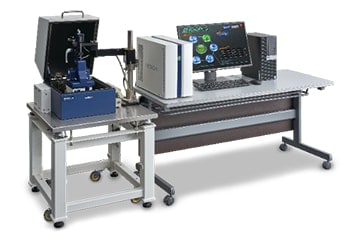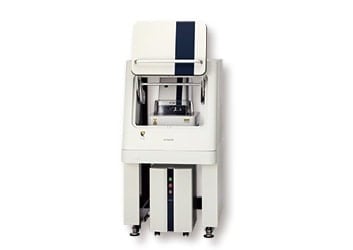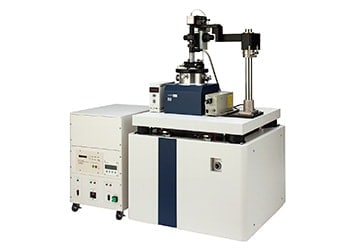By application

Automation / Ease of use
High accuracy / High resolution
- High-accuracy measurements of slanted surfaces with a steep slope
- High-accuracy measurements without damaging samples
- High-resolution measurements in a vacuum
- Stable and accurate measurements during sample heating and cooling
- High-accuracy topography measurements
- High-sensitivity MFM measurements in ambient or vacuum environments
- Humidity control / observations in liquid
Physical property measurements /
Environmental Controls
- Measurements of work functions in ambient or vacuum environments
- Observations of dopant distribution
- Quantitative measurements of elastic modulus
- Observations of structural changes in a vacuum
- Enabled true observations of topography and other physical properties
- Enabled quantitative measurements during sample heating and cooling
Automated probe exchange and optimization of imaging parameters
Applicable products:
Simple measurements
The probe exchange necessary for each measurement or sample can be performed via automatic detachment of the cantilever, lessening daily work load. In addition, by making the parameter settings performed during each measurement automatic, it is now possible, even for inexperienced operators, to easily perform measurement. This addresses difficulties with AFM operation and improves productivity.

By automatically exchanging the cantilever, it is possible to always have the appropriate probe available for use

Via automatic setting of parameters, it is possible to perform measurement under consistent conditions, regardless of the operator’s experience level.
Automated laser alignment
Applicable products:
Simple measurements
The adjustment of the laser to the cantilever that has previously required a skilled operator is no longer necessary. By incorporating a self-detection system into the cantilever included in the sensor, there is no variation due to different operators, while laser control and adjustment are performed automatically. This enables simpler measurement and improves productivity.
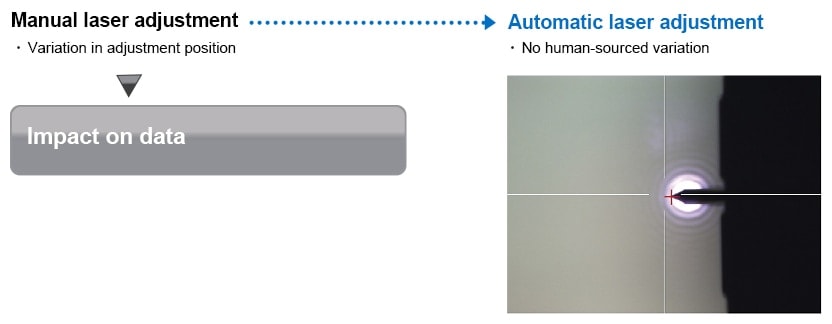
Measurement with little error thanks to automatic laser adjustment
Facilitated sample navigation with a software-controlled impact stage
Applicable products:
Simple measurements
Through the use of an impact stage, it is possible to easily adjust measurement position by manipulating a cursor on a CCD monitor, even without use of an electric stage. This greatly improves operability and enables speedy measurement when performing measurement in multiple locations on the same sample.

Easy adjustment of sample measurement position
High-accuracy measurements of slanted surfaces with a steep slope
Applicable products:
Intelligent measurement - SIS Mode
When measuring slanted surfaces with steep slopes in DFM mode, it is difficult to control scanning so that the tip is always the same distance from the sample and there is a tendency for separation to occur (parachuting). With SIS (Sampling Intelligent Scan) mode, the tip obtains data by approaching the sample only at points of measurement and otherwise moves in a horizontal direction above the sample, ensuring high-precision measurement, even when dealing with slanted surfaces with steep slopes.

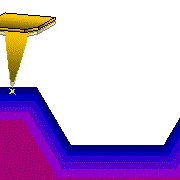

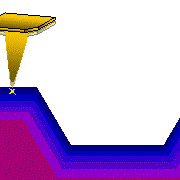
Examples of observation of slanted surfaces with steep slopes
High-accuracy measurements without damaging samples
Applicable products:
Intelligent measurement - SIS Mode
In DFM mode, samples that are soft or highly adsorbent may become deformed or damaged during measurement. With SIS (Sampling Intelligent Scan) mode, however, the probe is isolated vertically from the sample and moves in a horizontal direction, in order that lateral force does not cause the probe to push against the sample and to protect both probe and sample from damage, ensuring highly precise measurement.

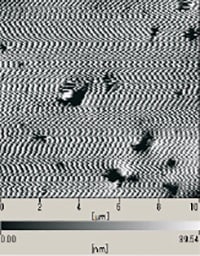
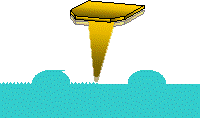
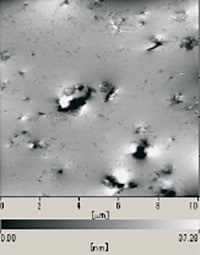
Examples of DFM, SIS phase mode observation of grease surfaces
High-resolution measurements in a vacuum
Applicable products:
Capable of AFM measurement in vacuum environments. When measuring electromagnetic properties in a high-vacuum environment, this model eliminates the influence of absorbed water, atmospheric gas molecules and humidity on the surface, preventing oxidation of the sample surface and enabling high-resolution measurement that results in an understanding of physical properties that is closer to theoretical values.

When performing imaging via SPMs with vibrating cantilevers, the viscosity resistance generated by gas molecules impacts the sensitivity of force detection.
By employing Q control in vacuum environments, it is possible to perform imaging with a higher degree of sensitivity.
Actual cases of observation of nanomagnetic hexagonal lattices with magnetic force microscopes (MFM)
Stable and accurate measurements during sample heating and cooling
Applicable products:
Since it can also measure in vacuum environments, this model is capable of stable measurement during heating and cooling. Unlike atmospheric heating, thermal oxidation does not impact surface topography or the convection of atmospheric gas. This enables stable measurement during heating or cooling over a full temperature range from -120°C to +800°C (measurement up to +300°C).
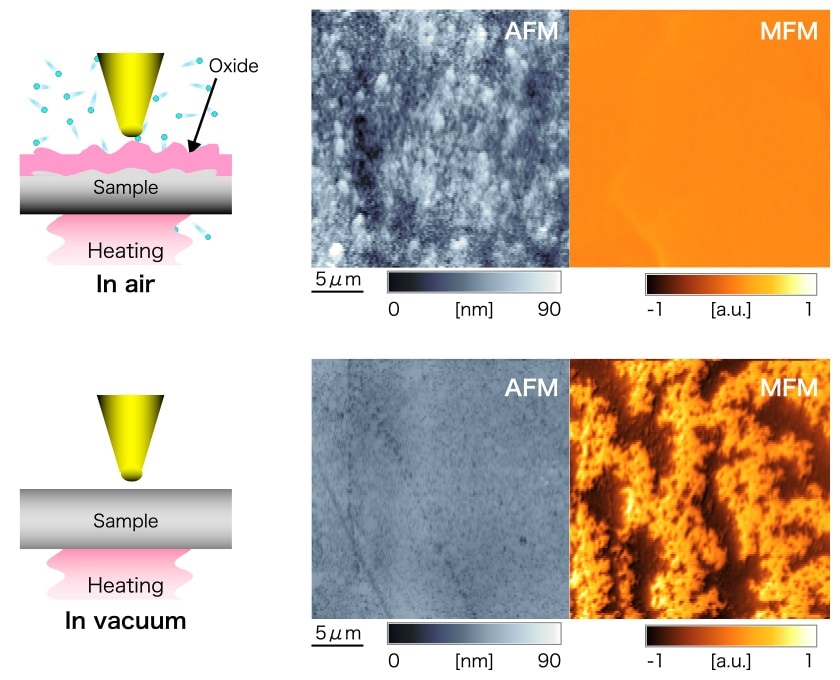
Heated measurement of a neodymium magnet with MFM in open-air and vacuum environments
Automated sample navigation for correlated AFM-SEM imaging at the same location
Applicable products:
“SÆMic.” is a one-piece solution that combines the topography, composition, and elemental analysis functions of SEMs with the ability of AFMs to conduct 3D measurement and analyze/evaluate mechanical (hardness, adsorbent, abrasive), electromagnetic (electrical current, resistance, potential), and magnetic (magnetism) properties. Through the use of a linkage holder, it also enables easy analysis/evaluation of identical points with a SEM and AFM.
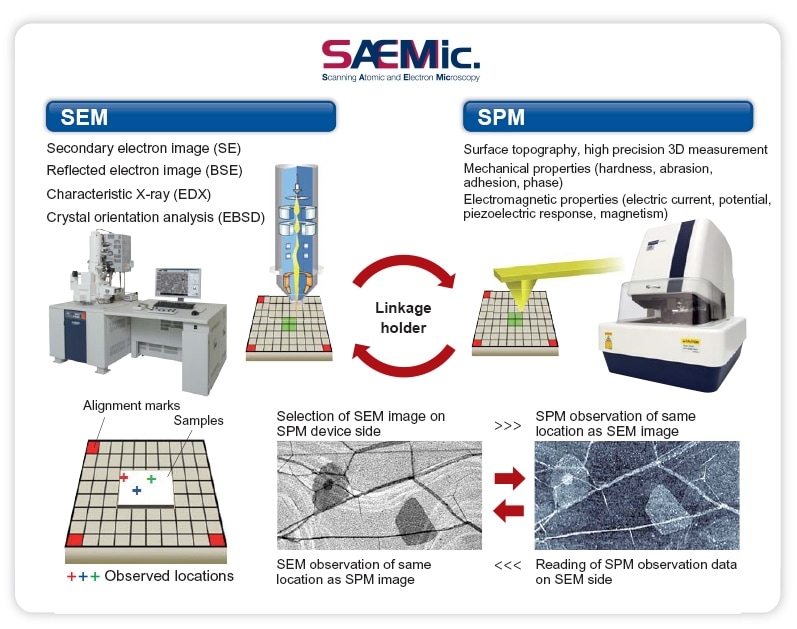
Enabling re-correlation analysis of SEM-AFM
High-accuracy topography measurements
Applicable products:
This model provides a solution for the curvature (crosstalk) that commonly occurs with telescopic vertical movement of the scanner, a tendency which has previously been a problem with AFM. By developing a new scanner that eliminates the impact of crosstalk when moving in a vertical direction, it is now possible to perform measurements with a left-right bending error of 0.5 degrees or less. This enables topography measurement of broad three-dimensional structures.
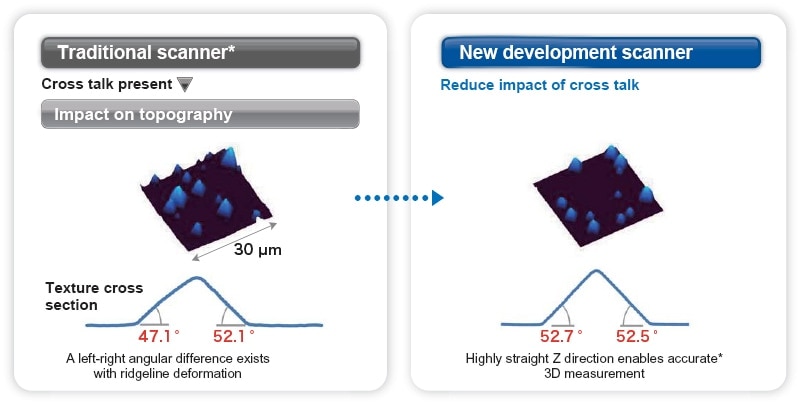
Observed sample: The textural structure of solar cells (symmetric left-right three-dimensional structure due to crystal orientation)
Measurements of work functions in ambient or vacuum environments
Applicable products:
This model is capable of carrying out KFM (Kelvin Force Microscopy) of a single sample in both open-air and vacuum environments. Even when using different measurement techniques in open-air and vacuum environments, there will be no gap in results and it is thus possible to calculate the impact of the environment (atmosphere/vacuum) on the calculation of work functions.
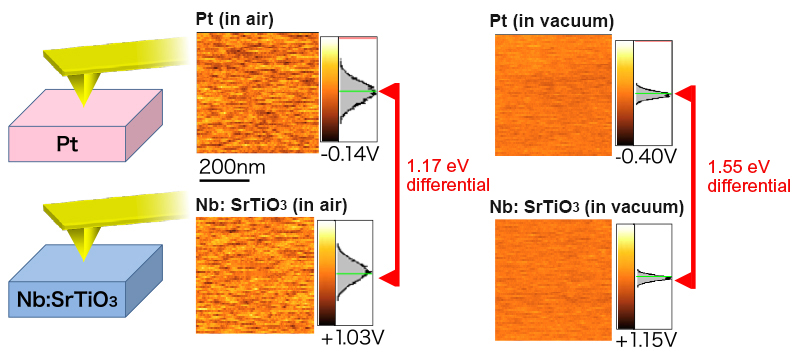
Cases of KFM measurement of metal Pt samples and NB dope SrTio 3 samples in vacuum and open-air environments
High-sensitivity MFM measurements in ambient or vacuum environments
Applicable products:
Capable of isolating and generating an image of the magnetic forces that affect magnetic tips and samples as variations in cantilever vibration. Since it can be used for measurement in a vacuum environment, there is little of the viscosity resistance generated by gas molecules and liquids that might occur in open-air environments or solutions. By setting appropriate Q options automatically, it also enables highly sensitive, high-resolution magnetic imaging.
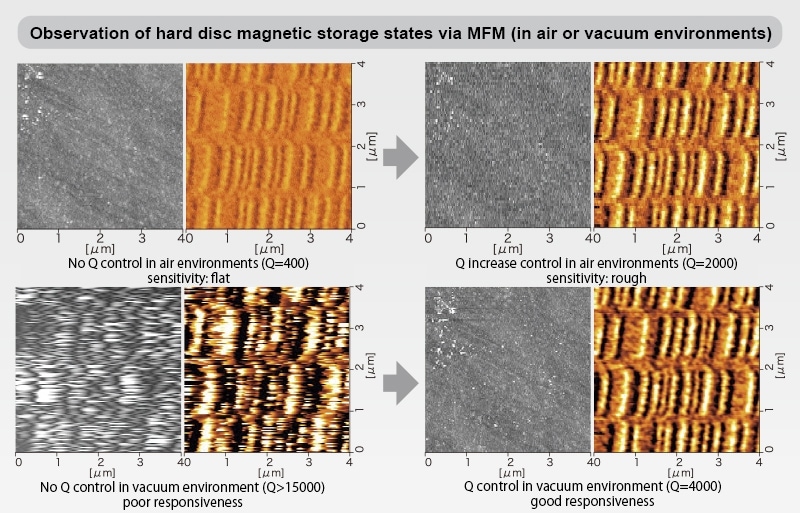
Observation of the magnetic recording states of hard disks via MFM
(atmosphere, vacuum)
Observations of dopant distribution
Applicable products:
While AFM analysis of semiconductor dopant distribution has been performed with SSRMs (Scanning Spreading Resistance Microscopes) and SCMs (Scanning Capacitance Microscopes) in the past, use of SNDM (Scanning Nonlinear Dielectric Microscopes) technology in vacuum environments enables low-density observation and highly precise measurement of CV property curves.
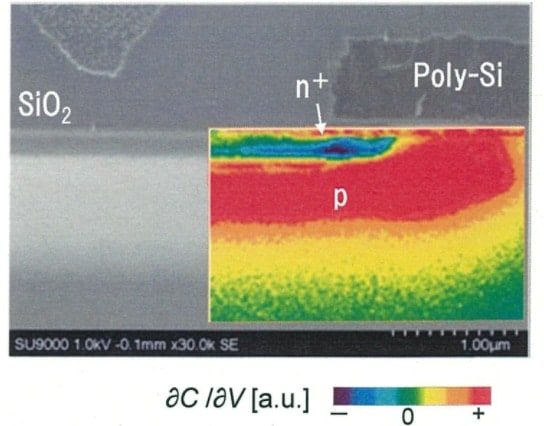
FE-SEM/SNDM observation results of SiC MOS FET
(Overlapping of SNDM images with SEM images)
Quantitative measurements of elastic modulus
Applicable products:
By employing an environmental control unit, this model can perform quantitative measurement of the elastic modulus in heated and chilled environments, or those where temperature/gas is controlled.
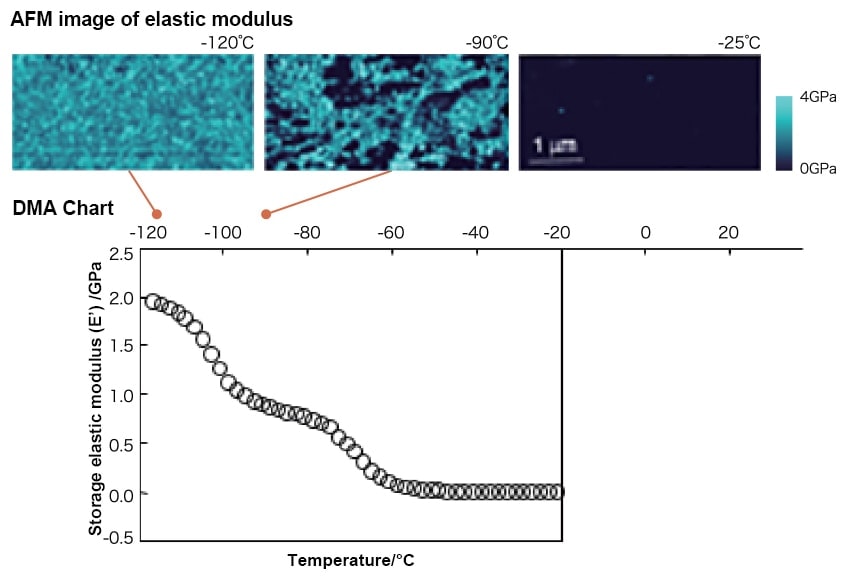
Actual case of elastic modulus mapping performed on rubber blends in a chilled environment
Humidity control / observations in liquid
Applicable products:
In addition to the previously mentioned open-air, high-vacuum, heated and chilled environments, the environmentally controlled atomic force microscope AFM5300E also includes options applicable to measurement during inert gas replacement, humidity control and liquid submersion. The figure illustrates the capabilities of these environmental control options by showing the results of AFM observation of electrolyte membrane fuel cells in low-humidity (10%), high-humidity (80%), and pure water environments. When humidity is high, you can see how the electrolyte membranes absorb water and swell to a larger size. In pure water, this swelling is even more pronounced, and we see a shift to rough surfaces.
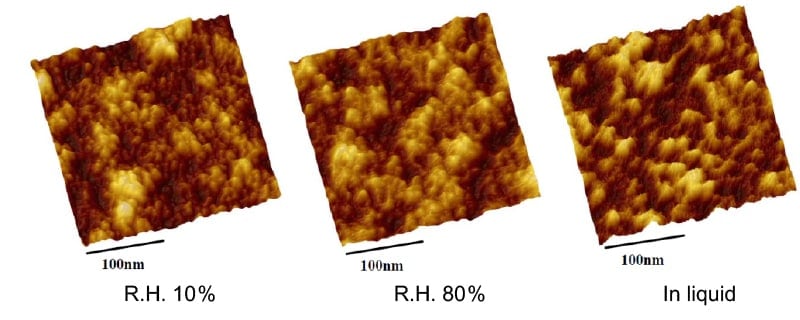
AFM observation of electrolyte membrane fuel cells in low-humidity (10%), high-humidity (80%), and pure water environments
Observations of structural changes in a vacuum
Applicable products:
In some polymer materials, volatile components such as low molecular weight components and residual solvents are sublimated or vaporized from the surface, leading to changes in material surface structure or composition. The figure shows structural changes observed with AFM in film-shaped polymer materials before and after approx. 30 minutes of evacuation. After evacuation, we see the emergence of surface roughness with undulations multiple nm in height.
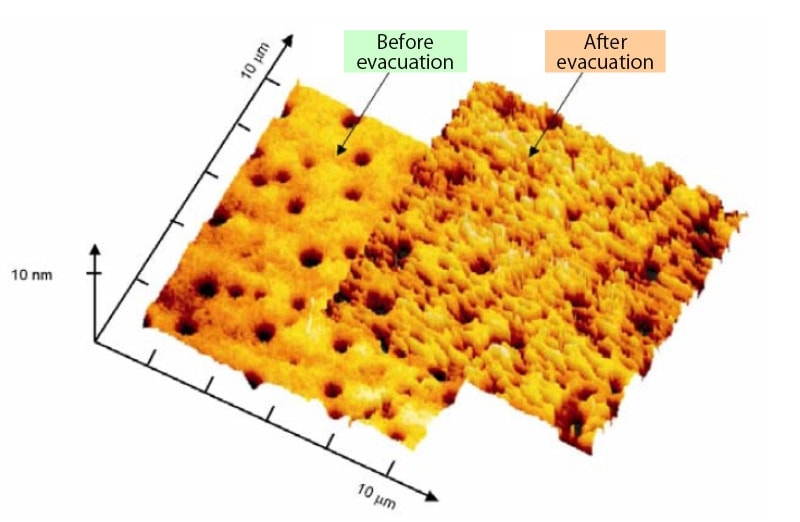
Structural changes occurring within film-shaped polymer materials in a vacuum environment
Enabled true observations of topography and other physical properties
Applicable products:
Simultaneous mapping of multiple functions with SIS-ACCESS
In addition to AFM topographic images, SIS-ACCESS can simultaneously capture various physical properties [deflection, topography derivation (edge emphasis), hardness, adhesion force, deformation, dissipation), electrical current or LM-FFM (Lateral Modulation Friction Force)]. Via the newly developed SIS Mode, it is also possible to choose weak force options with lower contact load than traditional methods, even as low as 1/10 the load of a traditional contact AFM.
Features
- Equipped with SIS mode that contains a new algorithm enabling low-force options
- Enables simultaneous capture of AFM topography and various physical properties [deflection, topography derivation (edge emphasis), hardness, adhesion force, deformation, dissipation), electrical current or LM-FFM (Lateral Modulation Friction Force)]
- Equipped with simultaneous capture and display functions over a maximum of 8 channels
Comparison of traditional AFM and SIS-ACCESS
·Traditional AFM: Lateral force works constantly and the probe pushes against soft sample surfaces, making capture of true sample surface information difficult. In the image on the right, observation reveals deformation of the soft domain portion as depressions.
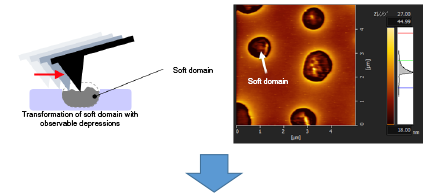
·SIS-ACCESS: Lateral movement and vertical movement take place in an area completely isolated from (above) the sample, preventing the probe from pushing into the sample due to lateral force. In the image on the right, observation reveals that deformation of the soft domain portion is suppressed and it is preserved in a state close to its original topography.
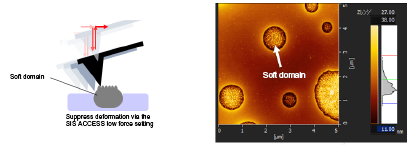
Applications
·Various physical properties of the polymer blends: From left, we see images of dissipation, deformation, adhesion, hardness, shape derivation (edge emphasis), and topography

This product is an optional product compatible with the company’s AFM5000II controller.
SIS is the name for the “Sampling Intelligent Scan” function developed by Hitachi. With SIS, the probe tip only makes contact with the sample at the time of data acquisition, and at other times it avoids the sample by moving on a plane above it in a horizontal direction at a higher speed compared to traditional methods. When it seems poised to make contact with the sample, scan speed is automatically reduced and the probe rises to avoid the sample surface.
Footnote 1: Obtains images that are closer to true topography than those taken with traditional methods.
Enabled quantitative measurements during sample heating and cooling
Applicable products:
Elastic modulus options - SIS-QuantiMech
SIS-QuantiMech transforms the load of each focus curve into an indentation volume curve and enables calculation of Young’s modulus by approximating each contact model. In addition, the newly developed SIS-ACCESS function and standard-equipped navigation function make several tasks intuitive and enable capture of topographic images and quantitative mechanical property evaluation to be performed simultaneously.
Features
- Simultaneously captures quantitative physical and topographic images
- Three types of quantitative imaging functions (elastic modulus, adhesion force, sample deformation)
- Compatible with each variety of contact theory model (Hertz, DMT, JKR 2-point method)
- Measurement of spring constant can be conducted by selecting between the thermal method and the size measurement method that involves calculation via image recognition from optical microscope images
- By employing an environmental control unit, this model can perform quantitative measurement of the elastic modulus in heated and chilled environments, or those where temperature/gas is controlled
Elastic modulus mapping performed on rubber blends in a chilled environment
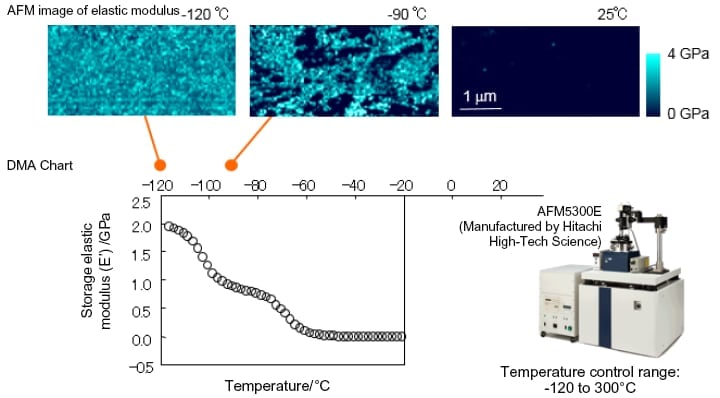
DMA and AFM measurement of the elastic modulus of gel
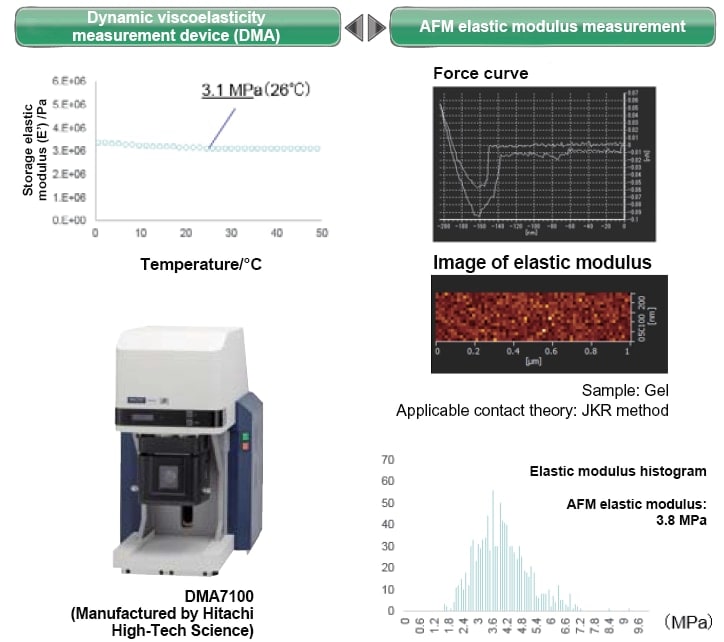
This product is an optional model compatible with Hitachi’s AFM5000II controller. Use of the product requires separate SIS-ACCESS.
SIS is the name for the “Sampling Intelligent Scan” function developed by Hitachi. With SIS, the probe tip only makes contact with the sample at the time of data acquisition, and at other times it avoids the sample by moving on a plane above it in a horizontal direction at a higher speed compared to traditional methods. When it seems poised to make contact with the sample, scan speed is automatically reduced and the probe rises to avoid the sample surface.
Product lineup
Hitachi AFM will prove useful at any stage
By application
Automation / Ease of use
High accuracy / High resolution
- High-accuracy measurements of slanted surfaces with a steep slope
- High-accuracy measurements without damaging samples
- High-resolution measurements in a vacuum
- Stable and accurate measurements during sample heating and cooling
- High-accuracy topography measurements
- High-sensitivity MFM measurements in ambient or vacuum environments
- Humidity control / observations in liquid
Physical property measurements /
Environmental Controls
- Measurements of work functions in ambient or vacuum environments
- Observations of dopant distribution
- Quantitative measurements of elastic modulus
- Observations of structural changes in a vacuum
- Enabled true observations of topography and other physical properties
- Enabled quantitative measurements during sample heating and cooling
This section introduces applications (actual measurement cases) for scanning probe microscopes (SPM/AFM).
Information for product users
This section offers information aimed at customers who use our scanning probe microscopes.
For first-time users
Related topics

“S.I.navi” is Hitachi Membership Site for analytical instruments users.
“S.I.navi” provides helpful information for daily analysis.

